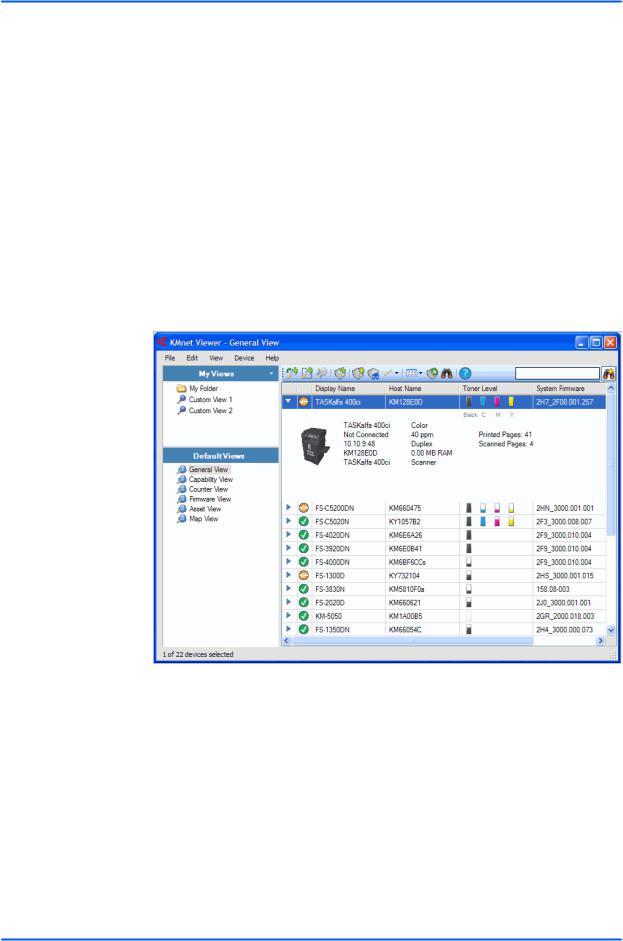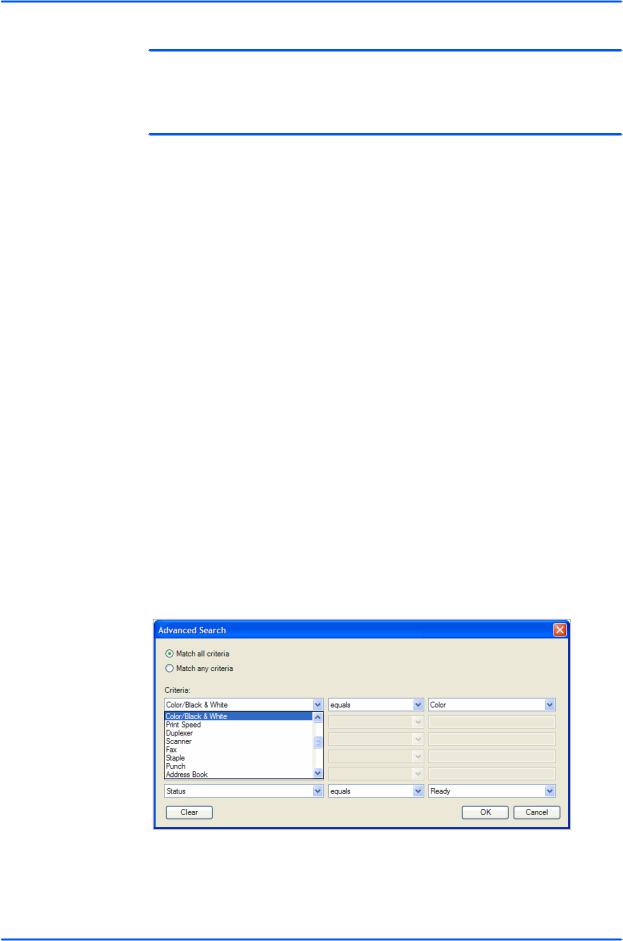Kyocera TASKALFA 250CI, TASKALFA 500CI, TASKALFA 300CI, TASKALFA 420I, TASKALFA 520I Manual
...
Legal Notes
Unauthorized reproduction of all or part of this guide is prohibited.
The information in this guide is subject to change for improvement without notice.
We cannot be held liable for any problems arising from the use of this product, regardless of the information herein.
Regarding Trademarks
•Microsoft Windows is a registered trademark of Microsoft Corporation in the U.S. and/or other countries. KPDL is a trademark of Kyocera Corporation. PCL is a trademark of Hewlett-Packard Company. TrueType is a registered trademark of Apple Computer, Inc.
•All other brand and product names herein are registered trademarks or trademarks of their respective companies.
Examples of the operations given in this guide support the Windows XP printing environment. Essentially the same operations are used for Microsoft Windows Vista, Windows Server 2008 and Windows 2000 environments.
Copyright © 2009 KYOCERA MITA Corporation ©2009 All rights reserved.
TC Rev. 1.0

Table of Contents
Chapter 1 Quick Start |
|
Starting and Logging in ................................................................................................................. |
1-1 |
Editing Authentication Options ...................................................................................................... |
1-1 |
Device Discovery .......................................................................................................................... |
1-2 |
Adding Devices ....................................................................................................................... |
1-2 |
Automatic Discovery ................................................................................................................ |
1-3 |
Excluded Devices .................................................................................................................... |
1-3 |
User Interface ............................................................................................................................... |
1-4 |
Application Menu ..................................................................................................................... |
1-4 |
Application Toolbar .................................................................................................................. |
1-5 |
My Views Pane ........................................................................................................................ |
1-5 |
Default Views Pane ................................................................................................................. |
1-5 |
Device List Pane ...................................................................................................................... |
1-5 |
Closing the Viewer Window ........................................................................................................... |
1-7 |
Chapter 2 |
View Management |
|
|
View As ......................................................................................................................................... |
2-1 |
|
Default Views ................................................................................................................................ |
2-1 |
|
Map View ................................................................................................................................. |
2-2 |
|
My Views ....................................................................................................................................... |
2-3 |
|
Adding a New Folder to My Views ................................................................................................. |
2-3 |
|
Renaming a Folder or View ........................................................................................................... |
2-3 |
|
Deleting a Folder, View, or Device ................................................................................................ |
2-3 |
|
Searches ....................................................................................................................................... |
2-4 |
|
Quick Searching ...................................................................................................................... |
2-4 |
|
Advanced Searching ............................................................................................................... |
2-4 |
|
Dynamic View ............................................................................................................................... |
2-5 |
|
Adding a Dynamic View ........................................................................................................... |
2-5 |
|
Manual View ................................................................................................................................. |
2-5 |
|
Adding a Manual View Using Selection ................................................................................... |
2-6 |
|
Updating a View ............................................................................................................................ |
2-6 |
|
Duplicating a View ......................................................................................................................... |
2-6 |
|
Renaming a View .......................................................................................................................... |
2-6 |
|
Deleting a View ............................................................................................................................. |
2-7 |
|
Resizing the View Areas ............................................................................................................... |
2-7 |
|
Refresh ......................................................................................................................................... |
2-7 |
Chapter 3 Device
Device Properties .......................................................................................................................... |
3-1 |
Displaying Device Properties ................................................................................................... |
3-2 |
Displaying Device Home Page ...................................................................................................... |
3-2 |
Address Book ................................................................................................................................ |
3-2 |
Adding Contacts ...................................................................................................................... |
3-2 |
Adding Groups ........................................................................................................................ |
3-3 |
Adding a Contact to a Group ................................................................................................... |
3-3 |
KMnet Viewer |
i |

|
Deleting a Contact From a Group ............................................................................................ |
3-3 |
|
Deleting Contacts and Groups ................................................................................................ |
3-4 |
|
Editing Contacts and Groups ................................................................................................... |
3-4 |
|
Copying Contacts and Groups ................................................................................................ |
3-4 |
|
Searching the Address Book ................................................................................................... |
3-5 |
|
Device Users ................................................................................................................................. |
3-5 |
|
Adding Device Users ............................................................................................................... |
3-5 |
|
Removing Device Users .......................................................................................................... |
3-5 |
|
Searching the Device User List ............................................................................................... |
3-6 |
|
Jobs .............................................................................................................................................. |
3-6 |
|
Showing Job Detail .................................................................................................................. |
3-6 |
|
Exporting the Job Log .............................................................................................................. |
3-6 |
|
Searching a Job List ................................................................................................................ |
3-7 |
|
Document Box .............................................................................................................................. |
3-7 |
|
Adding a Document Box .......................................................................................................... |
3-7 |
|
Deleting a Document Box ........................................................................................................ |
3-7 |
|
Document Properties ............................................................................................................... |
3-8 |
|
Document Views ..................................................................................................................... |
3-8 |
|
Downloading a Document ....................................................................................................... |
3-8 |
|
Searching a Document Box ..................................................................................................... |
3-8 |
|
Moving Documents Between Document Boxes ....................................................................... |
3-8 |
|
Notification Settings ...................................................................................................................... |
3-9 |
|
Setting a Notification ................................................................................................................ |
3-9 |
|
Communication Settings ............................................................................................................. |
3-10 |
|
Setting Device Communications ............................................................................................ |
3-10 |
|
TCP/IP Port ........................................................................................................................... |
3-11 |
|
Polling .................................................................................................................................... |
3-11 |
|
Advanced Menu .......................................................................................................................... |
3-11 |
|
TCP Send Data ..................................................................................................................... |
3-12 |
Chapter 4 |
Multi-Set |
|
|
Setting Multiple Devices ................................................................................................................ |
4-1 |
|
Selecting Settings in Multi-Set ...................................................................................................... |
4-1 |
|
Creating Settings From a Device .................................................................................................. |
4-2 |
|
Creating Settings From a File ........................................................................................................ |
4-2 |
|
Creating New Settings .................................................................................................................. |
4-3 |
|
Overwriting Settings ...................................................................................................................... |
4-3 |
Chapter 5 |
Firmware Upgrade |
|
|
Firmware Upgrade Risks ............................................................................................................... |
5-1 |
|
Firmware Upgrade Risks and Recovery Options ..................................................................... |
5-1 |
|
Performing Firmware Upgrade ...................................................................................................... |
5-2 |
|
Acknowledgement of Risks ..................................................................................................... |
5-3 |
|
Selecting a Firmware Upgrade File ......................................................................................... |
5-3 |
|
Verifying Upgrade Settings ...................................................................................................... |
5-3 |
|
Authorizing Firmware Upgrade ..................................................................................................... |
5-4 |
|
IB-2x Network Firmware .......................................................................................................... |
5-4 |
|
System and Fax Firmware ....................................................................................................... |
5-4 |
|
Beginning Firmware Upgrade ....................................................................................................... |
5-4 |
|
Canceling Firmware Upgrade ....................................................................................................... |
5-4 |
|
Saving the Firmware Upgrade Export File ..................................................................................... |
5-5 |
Chapter 6 |
Workspaces |
|
|
Adding a New Workspace ............................................................................................................. |
6-1 |
|
Opening an Existing Workspace ................................................................................................... |
6-1 |
ii |
User Guide |

Importing and Exporting a Workspace .......................................................................................... |
6-2 |
Importing a File to a New Workspace ...................................................................................... |
6-2 |
Exporting a Workspace to a File .............................................................................................. |
6-2 |
Exporting Device Information to a File ........................................................................................... |
6-2 |
Chapter 7 Viewer Options
Editing E-mail Options ................................................................................................................... |
7-1 |
Editing Authentication Options ...................................................................................................... |
7-2 |
Editing Device Polling Options ...................................................................................................... |
7-2 |
Editing SNMP Trap Options .......................................................................................................... |
7-3 |
Glossary .................................................................................................................................................................. |
iv |
Index ......................................................................................................................................................................... |
vi |
KMnet Viewer |
iii |

1 Quick Start
KMnet Viewer has many features to help you organize and monitor network device information.
These features are available for starting the viewer, discovering devices, and getting familiar with the user interface:
Starting and Logging in on page 1-1
Editing Authentication Options on page 7-2
Device Discovery on page 1-2
User Interface on page 1-4
Closing the Viewer Window on page 1-7
Starting and Logging in
1 |
In Microsoft Windows Vista or Windows XP, click Start > All Programs > |
|
Kyocera > KMnet Viewer. |
2 |
If you have administrator rights, your last saved workspace appears and you |
|
can proceed with your viewer tasks. If you have administrator rights, and you |
|
are starting KMnet Viewer for the first time, proceed to step 4. |
3 |
If you do not have administrator rights, the network administrator must set up a |
|
user login password for you. If no password has been set up, KMnet Viewer |
|
does not start, and an access error message appears. |
|
Type your password in the login text box, and click Submit. A password is a |
|
maximum of 32 characters. A blank password is allowed. |
|
If your submitted password is accepted, your last saved workspace appears, |
|
unless it is your first time starting the application. If it is the first time, proceed to |
|
step 4. |
|
If the password is not correct, the application displays the dialog box and asks |
|
you to enter the password again. If you incorrectly enter the password three |
|
times, an error message appears, and the applications does not start. If this |
|
happens see the network administrator about your password. |
4 |
If you just installed KMnet Viewer, and it is the first time you are starting it, a |
dialog box appears after you have started and successfully logged in to the application. You are asked to specify a workspace file. After you specify your workspace file, the viewer opens and displays the Add Device wizard to help you search for network devices and create the device list.
Editing Authentication Options
If a user does not have administrator rights on the computer with the viewer installed, the network administrator can set up a user login password. If no
1-1 |
User Guide |

Quick Start
password has been set up for a user without administrator rights, the application does not start, and an access error message appears.
1 In the menu bar at the top left of the screen, click Edit > Options >
Authentication.
2
3
4
5
Select Enable local password.
In the New password text box, type a password for a local user. A password is a maximum of 32 characters. A blank password is allowed.
In Confirm password, type the same password again.
Click OK to save the password.
Device Discovery
Discovery is a process that checks networks for printing devices. If new devices are found, then KMnet Viewer updates its database with information about the device. This process can be performed manually for single or multiple devices, or it can be scheduled to run automatically according to a set schedule. It is also possible to exclude devices from being discovered.
When KMnet Viewer is launched for the first time, or when a new workspace is opened, the Add Device wizard automatically launches.
Adding Devices
1
2
You can use the Add Devices wizard to add devices to the view list.
Click Device > Discovery > Add Devices.
In the Add Device wizard, select a method for adding devices:
Express
Uses predefined communication settings to find devices in the local network.
Custom
Lets you select settings to find devices on any network.
3 For the selected method, complete the wizard and click Finish to begin discovery.
Custom Options for Adding Devices
Custom options are available when Custom is selected in the Add Device Wizard. You can select the discovery process to run on your local network, a specific IP address, or a range of IP addresses. Continue through the wizard to select the following options:
On your local network
Select discovery type, TCP/IP port, SNMP options, and discovery start time.
By IP address
Type specific IP addresses or host names and click Add to add them to the Selected targets list. You can also click Import to search for a valid IP
KMnet Viewer |
1-2 |

Quick Start
address list (.CSV or .TXT). An entry can be removed from the Selected targets list by selecting it and clicking Remove. Click Next to continue through the wizard and select TCP/IP port, SNMP options, and discovery start time.
By IP address range
Type valid starting and ending IP addresses and click Add to add them to the Selected network segments list. An entry can be removed from the Selected network segments list by selecting it and clicking Remove. Click Next to continue through the wizard and select TCP/IP port, SNMP options, and discovery start time.
Automatic Discovery
You can set up a regular schedule for performing the discovery process. If devices are frequently added to or removed from the network, performing discovery on a regular basis will keep the device database up to date.
Scheduling Automatic Discovery
1 |
Click Device > Discovery > Automatic Discovery. The Scheduled Discovery |
|
dialog box opens. |
2 |
If there is an existing discovery mode you would like to edit, select it and click |
|
Properties, otherwise click Add to create a new discovery mode. |
3 |
In the Add Device Wizard , make your selections in each window to set up a |
|
recurring schedule. In the Confirm Discovery window, click Finish. |
4 |
The new discover mode is added to the list. Click Close to save your changes |
|
and exit the Scheduled Discovery dialog box. |
Excluded Devices
A printing device can be deleted, which excludes the device from the discovery process. This may be done if the device is not managed by the central IT department, or if the device is to be made not visible for security reasons.
Devices can be restored to the device list by performing Include Device.
Excluding a Device from Discovery
1
2
This option removes the device from the device list, and displays it in the Excluded Devices window. Information about the device is not deleted from the application.
In the device list, select the device to exclude.
Right-click on the selected device, and click Delete Device.
Including a Device
A printing device that was placed in the Excluded Devices window can be included again. When a device is included, it is available to be found the next time Discovery is performed.
1 Click Device > Discovery > Excluded Devices.
1-3 |
User Guide |

Quick Start
2
3
User Interface
In the list, select an excluded device to include.
Click Include Device.
The KMnet Viewer user interface is designed to help you quickly get the information you need about your network devices.
The screen is divided between left and right panes. On the left pane, you can select which view appears in the device list in the right pane. A view is a specified organization of columns and rows (list), or a layout (map) of the device data.
The application offers two types of views: user defined views that are listed under the My Views heading, and six standard views defined by KMnet Viewer that are listed under Default Views.
The device list in the right pane displays all devices found during network discovery. There is one row of information per device.
Application Menu
The application menu is located in the upper left corner of the KMnet Viewer screen. Basic operations that affect the viewer are in this menu. The application menu operates like a standard Microsoft Windows application menu. The main menu titles are:
File
Edit
View
Device
Help
KMnet Viewer |
1-4 |

Quick Start
Application Toolbar
The application toolbar appears above the device list and provides buttons for commonly used features. Move the cursor over the button to see a description of the feature. Click to use the feature. If a feature is not available, the button is disabled. The toolbar contains buttons for the following features:
Add Dynamic View
Add Manual View Using Selection
Update View
Add Devices
Properties
Device Homepage
Edit
View As
Refresh Device
Advanced Search
Help
For Map View, the toolbar also contains buttons for the following features:
Import Map Background
Zoom In
Zoom Out
Zoom to Fit
Zoom %
My Views Pane
My Views are located in the left pane of the screen. My Views are lists or maps you can create from Default Views or other My Views. This lets you customize the type of information you want to see. My Views are organized in a tree structure that displays folders and My Views nodes. When you select a My Views node, KMnet Viewer displays the view (list or map) in the right pane. You can create folders to organize and manage My Views. Add device information to a view by clicking View > Add Dynamic View, or View > Add Manual View Using Selection.
Default Views Pane
Default Views are located in the left pane of the screen. Default Views are standard list or map views shipped with KMnet Viewer. Six standard views are available under Default Views that cannot be removed. When you select a particular default view, KMnet Viewer displays the view (list or map) in the right pane.
Device List Pane
The device list is located in the right pane of the screen. It provides device information in a customizable list or in a map format. Information can be organized and sorted to the user’s preference. Each row represents a device and columns represent categories. Each device row can be expanded to display more information.
1-5 |
User Guide |

Quick Start
Identifying Status Icons
In the device list, status icons provide quick information about the condition of each device. Click the triangle icon to expand the row and see a description of the condition.
Ready
Green icon with a white check mark. This icon indicates the device is ready to print, or is in the process of printing.
Error
Red icon with white “X”. This icon means the device is unable to print and needs immediate attention. It may be a paper jam, cover open, no toner, no paper, or the device has gone offline.
Warning
Yellow icon with a white exclamation mark. This icon indicates the device can print, but is approaching error status. It may mean low toner or low paper.
Disconnected
Orange icon with a white broken circuit. This icon means the viewer is unable to communicate with the device. The device may be powered off, or there may be a problem with the network connections.
Busy
Gray icon with a white arrow. This icon indicates the device is operational, but occupied with a task. It may be undergoing an upgrade or configuration.
Customizing the Device List
KMnet Viewer provides the ability to arrange the information in the device list to suit your needs. Changes made to My Views are saved with the view. You can update changes to My Views by clicking Update View in the toolbar. Changes made to Default Views are not saved after you leave the view.
Showing or Hiding Columns
Find the column to the right of where you want a new column to appear. Right-click on the column heading to open the selection list of columns. A column that appears in the view has a check mark next to it in the selection list. Select a new column for the view by clicking on the desired column name. The column will now appear in the view.
To hide a column from the view, click any column heading to open the selection list of columns. Click on a column name that has a check mark next to it that you want to hide. The column will no longer appear in the view.
Changing the Width of a Column
To adjust the width of a column, position the cursor over the column divider until you see the double-headed arrow. Left-click, and then drag the arrow left or right until you have the desired column size. Release the mouse button.
Changing the Position of a Column
To move a column to another position in the view, left-click on the desired column heading, and then drag the cursor to a column heading name that is to the left of where you want the moved column to appear. Release the mouse button.
Sorting Rows in the Device List
You can sort the information in the device list. Click the column heading to change the sort order of the rows in the view, using the data in that column as
KMnet Viewer |
1-6 |

Quick Start
the sort criteria. An upward triangle indicates rows sorted in ascending order; a downward triangle indicates rows sorted in a descending order.
Expanding a Row in the Device List
You can expand a row in the device list to reveal more information about a device. Click the right-pointing triangle icon in the row of the device for which you want to see additional information. The row expands to display a 3–D picture of the device with all installed options. Other information about the device is also displayed, such as model, status, IP address, and print speed.
To collapse the row back to regular device list size, click the triangle icon again.
Closing the Viewer Window
You can close just the viewer window so that the device list is no longer visible on the screen, but the application continues to run in the system tray. This is useful if you want to reduce the number of open windows on your desktop, or if you are running a viewer task that does not need visual monitoring. In the menu bar at the top left of the screen, click File > Close Window. To reopen the window, double-click the viewer icon in the system tray; or right-click the icon, and then click Restore.
To exit the application, click File > Exit. The application saves the currently displayed workspace before exiting. This saved workspace appears the next time the same user opens the application.
1-7 |
User Guide |

2 View Management
KMnet Viewer offers two types of views: user defined views that are listed under the My Views heading, and six standard views defined by KMnet Viewer that are listed under Default Views. The default views are General View,
Capability View, Counter View, Firmware View, Asset View, and Map View.
You can create, change, or delete views in My Views. In the Default Views, you can customize the appearance of the lists, but the changes are not saved after you leave the view. You cannot make permanent changes to the views in
Default Views.
These view features are available:
Default Views on page 2-1
Importing a Map Background on page 2-2
My Views on page 2-3
Searches on page 2-4
Adding a Dynamic View on page 2-5
Adding a Manual View Using Selection on page 2-6
Resizing the View Areas on page 2-7
Refresh on page 2-7
View As
You can switch to a different view by using the View As feature in the View menu. Select the view you want to change, click View > View As, and click the new view from the list.
•If the original view is under Default Views, the view switches to the selected default view.
•If the original view is under My Views, the view itself changes to the selected view. To save the view, click Update View.
Default Views
KMnet Viewer provides six standard views under Default Views that cannot be removed or edited. Display Name, IP Address and Host Name are included in all views.
In any view except Map View, you can add or remove columns from the table temporarily. Right-click on the column heading and select or clear the desired item or items. The modified views are not saved when you switch to a different view.
The following default views are available:
General View
Displays general information, such as display name, IP address, host name, toner level, description, location, and model name.
KMnet Viewer |
2-1 |

View Management
Capability View
Displays support for various device capabilities, such as color or black & white, print speed, duplex, total memory, scan, fax, staple, punch, address book, document box, user list, and job log.
Counter View
Displays the device counters for total printed page, printed page copier, printed page printer, printed page FAX/i-FAX, printed page black & white, printed page single color, printed page full color, total scanned pages, scanned page copier, and scanned page other.
Firmware View
Displays firmware information, including system firmware, engine firmware, scanner firmware, FAX firmware, panel firmware, and NIC version.
Asset View
Displays asset information, including MAC address, serial number, and asset number.
Map View
Displays printing devices on a background map of your office.
Map View
Use Map View to display printing devices on a background map of your office. Printing device properties can be viewed and managed from Map View. The use of an office map helps to visualize the location of devices throughout an office.
Under Default Views, click Map View. The initial map view displays all devices as icons against a white background. You can import an image of your office layout to appear in the background, then click and drag each device icon to its office location. The map is shared by all map views in the current workspace.
Information about a device can be viewed by moving the pointer over the icon.
Importing a Map Background
1
2
3
4
You can import an image of your office layout to appear in the map view background. After an image is imported, you can replace it with another image by following the same procedure.
Under Default Views, select Map View.
Click View > Import Map Background.
Click Browse to select an image file (.BMP or .JPG).
Click OK in the Import Map Background dialog box.
Adjusting the Map Size
You can change the size of the map image within the view window.
Use any of the following methods to change the image size:
•Click Zoom In to increase the size of the image one step.
•Click Zoom Out to decrease the size of the image one step.
•Click Zoom to Fit to place the entire image within the screen. If you change the screen size, click Zoom to Fit again.
2-2 |
User Guide |

View Management
•Type a percentage between 50% and 300% in the Zoom box and press
Enter.
Clearing a Map Background
You can remove the background image from the map view. All device icons will retain their position after the map image is removed.
• In the View menu, click Clear Map Background.
My Views
You can set up custom views in addition to the default views. Custom views appear on the left side of the screen under My Views. Dynamic or manual views can be created or deleted. If desired, views can be placed in folders.
My Views lets you customize the devices being displayed, as well as column order, number of columns, and other view settings. To save the view, click
Update View.
Adding a New Folder to My Views
1 |
In the menu bar at the top left of the screen, click File > New Folder. A folder |
|
with the temporary name of New Folder is created in the My Views pane for the |
|
active Workspace. |
2 |
Click in the text box, and type a name for the folder. The name cannot be the |
|
same as that of an already existing folder. |
3 |
To save the new folder name, click outside the text box, or press Enter. |
Renaming a Folder or View
1 In the My Views pane at the left of the screen, click to highlight the view or folder you want to rename.
2
3
4
In the menu bar at the top left of the screen, click Edit > Rename.
Type the new name, replacing the old name in the text box.
To save the new name, click outside the text box, or press Enter.
Deleting a Folder, View, or Device
The delete feature deletes items based on what is selected in the KMnet
Viewer screen.
1 In the My Views pane at the left of the screen, click to select the view or folder you want to delete; or in the device list, click to select the device you want to delete. Multiple devices can be selected using Ctrl or Shift. Deleting a folder also deletes all folders and views contained in that folder.
KMnet Viewer |
2-3 |

View Management
2 In the menu bar at the top of the screen, click Edit > Delete.
Warning: There is no confirmation dialog box after you click delete for a folder or view. A deleted folder or view cannot be restored. A deleted device can be restored to the device list by clicking, in the menu bar at the top left of the screen, Device > Discovery > Excluded Devices. Then select your device from the list and click Include Device.
Searches
Two types of searches are available for finding devices with particular characteristics. Quick Search searches text columns in the currently displayed device list. Quick Search entries are not saved when you move from view to view, or change to Advanced Search. Advanced Search searches all devices in the database for the values selected in the search dialog box.
Quick Searching
The Quick Search feature is located at the upper right of the screen. The Quick Search text box accepts input in all supported languages. Type a search term (64 character maximum), then click the binoculars and lightning bolt icon, to perform a full text search on the text columns (Display Name, IP Address, Host Name, and Model Name) for the devices in the currently displayed list. On completion of the search, the device list only shows items that match the search term.
To clear a Quick Search, delete any search term in the Quick Search text box, then click the Quick Search icon.
Quick Search terms are not saved when you move from view to view, or perform an Advanced Search. Quick Search does not search the text in the expanded row area.
Advanced Searching
The Advanced Search feature is available for Default Views. It finds all printing devices in the database that match the selected criteria. Up to six properties can be defined for the search. The search results are displayed until you change to another view, or perform another Advanced Search.
1 |
Select a Default View. |
2 |
Click Edit > Advanced Search, or click the binoculars icon in the application |
|
toolbar above the device list. The Advanced Search dialog box opens. |
2-4 |
User Guide |
